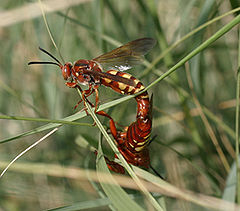- Sphecius
-
- "Cicada killer wasp" redirects here. See also below for other taxa named thus.
Cicada killer wasps 
Mating Western Cicada Killers, Sphecius grandis (Big Bend, Texas, USA). The male is uppermost. Scientific classification Kingdom: Animalia Phylum: Arthropoda Subphylum: Hexapoda Class: Insecta Subclass: Pterygota Infraclass: Neoptera Superorder: Endopterygota Order: Hymenoptera Suborder: Apocrita Infraorder: Aculeata Superfamily: Apoidea Family: Crabronidae Subfamily: Bembicinae Tribe: Gorytini Genus: Sphecius
Dahlbom, 1844Species Some 21, see text
Cicada killer wasps (the genus Sphecius) are large, solitary, ground dwelling, predatory wasps. They are so named because they hunt cicadas and provision their nests with them, after stinging and paralyzing them. There are 21 species worldwide. The highest diversity occurs in the region between North Africa and Central Asia.
In North America, the term "cicada killer wasp" usually refers to the most well-known species, the Eastern cicada killer (S. speciosus). There are also a few other related genera sometimes referred to as "cicada killers", e.g. Liogorytes in South America and Exeirus in Australia.
The use of cicadas as prey is in keeping with the typical behavior of the tribe Gorytini, which tend to specialize on various members of the Cicadomorpha as prey items.
Contents
Species
This list of species is probably complete as of March 31, 2009. It has been adapted from the Catalog of Sphecius species (California Academy of Sciences). Notable subspecies are also given.
More recently, it has been suspected that the Western cicada killer (S. grandis) represents more than one species. There is also evidence to suggest that either the Eastern cicada killer (S. speciosus) has a subspecies or closely related species that mimics the Pacific cicada killer (S. convallis). Alternatively, when they were already well distinct species, significant hybridization has occurred between them, though not enough to fully overcome their reproductive isolation.[1]
- Sphecius antennatus (Klug, 1845) (Southern and Eastern Europe, Middle East, Central Asia)
- Sphecius citrinus Arnold, 1929 (South Africa)
- Sphecius claripennis Morice, 1911 (North Africa)
- Sphecius conicus (Germar, 1817) (Balkans, Kazakhstan, Turkey, Greece)
- Sphecius conicus creticus de Beaumont, 1965 (Crete)
- Sphecius conicus syriacus (Klug, 1845) (Syria to China)
- Sphecius convallis Patton, 1879 – Pacific cicada killer (California, Mexico)
- Sphecius grandidieri (de Saussure, 1887) (Madagascar)
- Sphecius grandis (Say, 1823) – Western cicada killer (Nevada, Arkansas, Colorado, Mexico)
- Sphecius hemixanthopterus Morice, 1911 (Algeria)
- Sphecius hogardii (Latreille, 1806) – Caribbean cicada killer (West Indies, Florida)
- Sphecius hogardii bahamas Krombein, 1953 (Bahama Islands: Bimini)
- Sphecius intermedius Handlirsch, 1895 (Algeria)
- Sphecius lutescens (Radoszkowski, 1877) (Central Asia)
- Sphecius malayanus Handlirsch, 1895 (Indonesia: Timor, Sumbava)
- Sphecius milleri R.Turner, 1915 (Zambia)
- Sphecius milleri aurantiacus Arnold, 1940 (Ethiopia)
- Sphecius nigricornis (Dufour, 1838) (Southern and Eastern Europe, North Africa)
- Sphecius pectoralis (F.Smith, 1856) (Australia)
- Sphecius persa Gussakovskij, 1933 (Iran, Afghanistan)
- Sphecius quartinae (Gribodo, 1884) (Guinea, Somalia)
- Sphecius schulthessi Roth, 1951 (North Africa)
- Sphecius speciosus (Drury, 1773) – Eastern cicada killer (Central and North America: Honduras to Canada)
- Sphecius spectabilis (Taschenberg, 1875) – South American cicada killer (Brazil, Argentina)
- Sphecius uljanini (Radoszkowski, 1877) (Kazakhstan, Turkmenistan, Iran)
Footnotes
- ^ Hastings et al. (2008)
References
- Hastings, Jon M.; Schultheis, Patrick J.; Whitson, Maggie; Holliday, Charles W.; Coelho, Joseph R. & Mendell, Angela M. (2008): DNA barcoding of new world cicada killers (Hymenoptera: Crabronidae). Zootaxa 1713: 27–38. PDF fulltext
External links
- cicada killers, Sphecius spp. on the UF / IFAS Featured Creatures Web site

This wasp-related article is a stub. You can help Wikipedia by expanding it.
